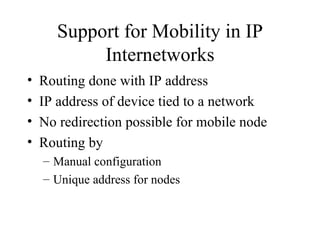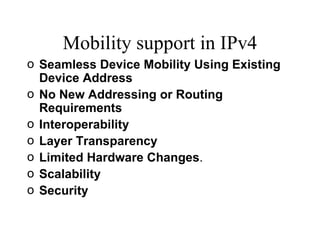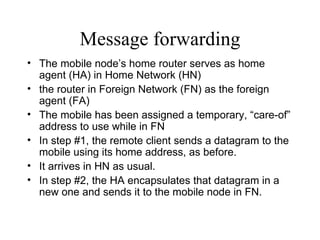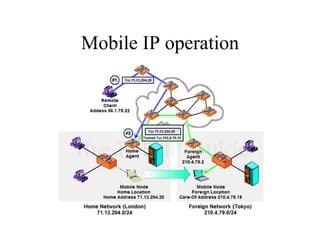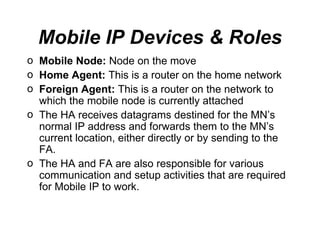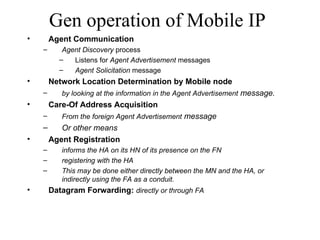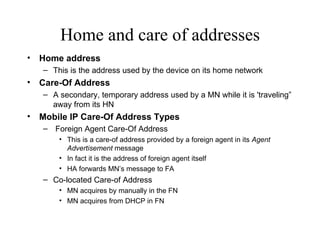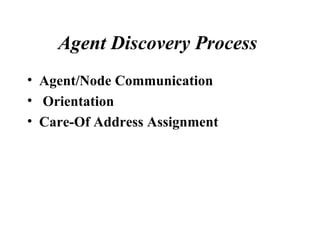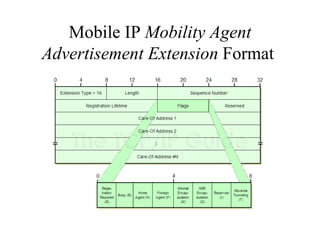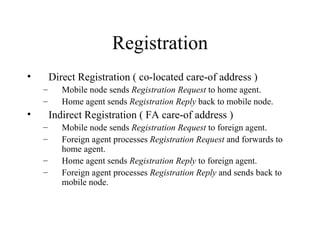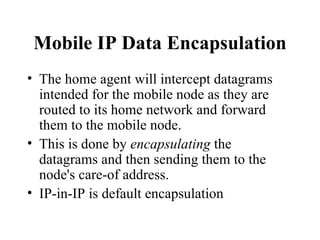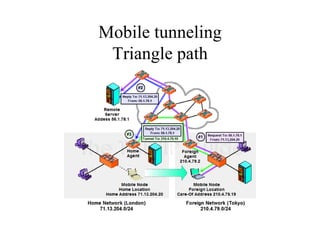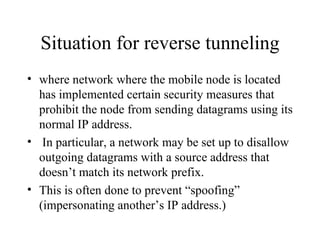Mobility And Mobile I Pv4
- 2. Support for Mobility in IP Internetworks Routing done with IP address IP address of device tied to a network No redirection possible for mobile node Routing by Manual configuration Unique address for nodes
- 3. Mobility support in IPv4 Seamless Device Mobility Using Existing Device Address No New Addressing or Routing Requirements Interoperability Layer Transparency Limited Hardware Changes . Scalability Security
- 4. Mobility overview Implementing a forwarding system for mobile devices When a mobile unit is on its “home” network, it functions normally When it moves to a different network, datagrams are sent from its home network to its new location This allows normal hosts and routers that don't know about Mobile IP to continue to operate as if the mobile device had not moved Special services required to implement Mobile IP: Letting a mobile device determine where it is Telling the home network where to forward messages etc Mobile IP was designed under the specific assumption that the attachment point would not change more than once per second
- 5. Message forwarding The mobile node’s home router serves as home agent (HA) in Home Network (HN) the router in Foreign Network (FN) as the foreign agent (FA) The mobile has been assigned a temporary, “care-of” address to use while in FN In step #1, the remote client sends a datagram to the mobile using its home address, as before. It arrives in HN as usual. In step #2, the HA encapsulates that datagram in a new one and sends it to the mobile node in FN.
- 7. Mobile IP Devices & Roles Mobile Node: Node on the move Home Agent: This is a router on the home network Foreign Agent: This is a router on the network to which the mobile node is currently attached The HA receives datagrams destined for the MN’s normal IP address and forwards them to the MN’s current location, either directly or by sending to the FA. The HA and FA are also responsible for various communication and setup activities that are required for Mobile IP to work.
- 8. Gen operation of Mobile IP Agent Communication Agent Discovery process Listens for Agent Advertisement messages Agent Solicitation message Network Location Determination by Mobile node by looking at the information in the Agent Advertisement message. Care-Of Address Acquisition From the foreign Agent Advertisement message Or other means Agent Registration informs the HA on its HN of its presence on the FN registering with the HA This may be done either directly between the MN and the HA, or indirectly using the FA as a conduit. Datagram Forwarding: directly or through FA
- 9. Home and care of addresses Home address This is the address used by the device on its home network Care-Of Address A secondary, temporary address used by a MN while it is 'traveling” away from its HN Mobile IP Care-Of Address Types Foreign Agent Care-Of Address This is a care-of address provided by a foreign agent in its Agent Advertisement message In fact it is the address of foreign agent itself HA forwards MN’s message to FA Co-located Care-of Address MN acquires by manually in the FN MN acquires from DHCP in FN
- 10. Agent Discovery Process Agent/Node Communication Orientation Care-Of Address Assignment
- 11. Mobile IP Messages Agent Advertisement This is a message transmitted regularly by a router acting as a Mobile IP agent. It consists of a regular Router Advertisement message that has one or more extensions added that contain Mobile-IP-specific information for mobile nodes Agent Solicitation Messages This message can be sent by a mobile IP device to nudge a local agent to send an Agent Advertisement.
- 12. Mobile IP Mobility Agent Advertisement Extension Format
- 13. Registration Direct Registration ( co-located care-of address ) Mobile node sends Registration Request to home agent. Home agent sends Registration Reply back to mobile node. Indirect Registration ( FA care-of address ) Mobile node sends Registration Request to foreign agent. Foreign agent processes Registration Request and forwards to home agent. Home agent sends Registration Reply to foreign agent. Foreign agent processes Registration Reply and sends back to mobile node.
- 14. Registration messages Registration is performed by the mobile node sending a Registration Request message the home agent returns a Registration Reply . The foreign agent may be required to act as a “middleman” to facilitate the transaction, but is otherwise not involved
- 15. Mobile IP Data Encapsulation The home agent will intercept datagrams intended for the mobile node as they are routed to its home network and forward them to the mobile node. This is done by encapsulating the datagrams and then sending them to the node's care-of address. IP-in-IP is default encapsulation
- 16. Mobile IP data Delivery tunnel The start of the tunnel is the home agent The end of the tunnel depends on what sort of care-of address is being used: Foreign Agent Care-Of Address:- FA Co-located care-of Address:- Mobile Node
- 17. Triangle delivery path Normally, the tunnel is used only for datagrams that have been sent to the mobile node and captured by the home agent. When the mobile nodes wants to send a datagram, it doesn't tunnel it back to the home agent; this would be needlessly inefficient. Instead it just sends out the datagram directly using whatever router it can find on its current network, which may or may not be a foreign agent. When it does this, it uses its own home address as the source address for any requests it sends. As a result, any response to those requests will go back to the home network. This sets up a “triangle” of sorts for these kinds of transactions
- 18. Mobile tunneling Triangle path
- 19. Mobile IP Reverse Tunneling A reverse tunnel is set up between the mobile node and the home agent, or between the foreign agent and the home agent, depending on care-of address type. All transmissions from the mobile node are tunneled back to the home network where the home agent transmits them over the internetwork A more symmetric operation rather than the “triangle” path This is needlessly inefficient, because it means each communication requires four steps. Thus, it is used only when necessary.
- 20. Situation for reverse tunneling where network where the mobile node is located has implemented certain security measures that prohibit the node from sending datagrams using its normal IP address. In particular, a network may be set up to disallow outgoing datagrams with a source address that doesn’t match its network prefix. This is often done to prevent “spoofing” (impersonating another’s IP address.)


